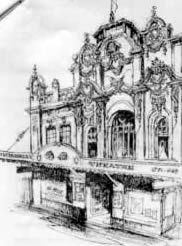

The INDEPENDENT THEATRE COMPANY was founded in Sydney in May 1930 with Doris Fitton as its artistic director. Fitton's policy was to present plays not usually attempted by professional managements of the time, a viewpoint reflecting the influence of J.T. Grein's British Independent Theatre Club on the new company. They used various venues until 1939 when they moved to an established theatre in Miller Street at North Sydney, which they renamed the Independent Theatre.
In 1885-6 a building to house the power house and carriage sheds for the cable tram was constructed on a double block of land at 269 Miller Street, North Sydney. The tram depot then between 1900 and 1910 progressively moved to Neutral Bay. The Miller Street building was modified to include shops and partly demolished in 1902 and then in 1911 North Sydney Coliseum Pty. Ltd. was granted a licence to operate a hall and a cinema on the site.
The cinema became a factory and showroom and was later demolished and replaced by home units. The hall, licensed to seat seven hundred and seventy eight people for general entertainment, was leased by Harry Clay in 1918 as part of his suburban vaudeville circuit. Clay's Circuit closed in 1930 and the hall, with its seating capacity reduced to five hundred, was licensed for short term entertainments, including as a boxing stadium. The building was relicensed as the COLISEUM THEATRE in 1937, and had a series of short tenancies. It was briefly known as the Criterion Theatre and also operated as the KURSAAL THEATRE run by Scott Alexander, the founder of the Sydney Repertory Theatre. Following Alexander's death, the theatre's fittings were sold to the INDEPENDENT THEATRE COMPANY.
The INDEPENDENT THEATRE COMPANY opened their theatre, under the new name, with
a production of `French without Tears' on 3 September, 1939, one day before
war was declared. The company continued its policy of uninterrupted production
throughout the war and, although initially it lost subscribers because of its
move north of the harbour, it slowly built up a loyal local following. The theatre,
stalls on a sloping floor with a small, somewhat rickety gallery along the back,
held between four hundred and fifty and five hundred people, and this was a
large capacity for a subscription based operation.
In late 1947 the site's owners attempted to close the theatre and convert it to a furniture warehouse, but a public meeting generated sufficient public support to raise ten thousand pounds to buy the building for the use of the Independent Theatre. The company then operated in North Sydney, usually on a semi-professional basis, for the rest of its long life, surviving mainly because of the driving force of Doris Fitton and the devotion of its supporters. Both Fitton and the company, which was then in severe financial difficulties, finally left the building in May 1977. .
During its time as the Independent Theatre the theatre remained basically unaltered. The building was not well constructed and it was poorly maintained, with continued complaints from the 1920s about its condition. It was hot in summer, cold in winter and the roof leaked.
The auditorium, painted dusty pink, was reached by a long downward sloping corridor, which ended in a small cramped foyer. There was a proscenium arched, shallow and poorly equipped stage, with very little wing or backstage area. There were two dressing rooms behind the stage and an area known as the Crib underneath it, where wardrobe and everything else, including actors other than the star performers, was accommodated. Scenery construction was in lean-to sheds behind the building or in the open alley beside the auditorium. Upstairs, in a rabbit warren of rooms, there were offices and an area known as the Studio where the Independent Theatre School operated.
After Fitton retired, the Independent Theatre survived precariously on short term leases until 1993. There were attempts to have the building used by existing theatre organisations but nothing came to fruition until in 1993 it was bought by the Seaborn, Broughton and Walford Foundation. By then the theatre was in a very poor state of repair, but the Foundation, in association with North Sydney Municipal Council and dedicated supporters, undertook extensive restoration work. The newly restored and partially redecorated theatre was re-opened as the SBW Independent Theatre in 1998.
Sources:
Carolyn Lowry, The SBW Independent Theatre: a brief history (North Sydney,
SBW Friends of the Independent Theatre, 2001)
Ailsa McPherson, A Dream of Passion (North Sydney, Municipality of North
Sydney, 1993)
P. Parsons (ed.) with V. Chance, Companion to Theatre in Australia (Sydney,
Currency Press in association with Cambridge University Press, 1995)
Writer's recollections